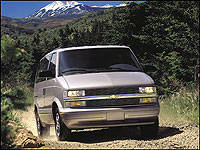Ode to a Faithful Example of Endurance
On Tuesday, November 16, 2004, General Motors officially ended speculation and announced that it's Chevy Astro and GMC Safari
 |
| On Tuesday, November 16, 2004, General Motors officially ended speculation and announced that it's Chevy Astro (shown) and GMC Safari rear-drive mid-vans were to be discontinued in 2005. (Photo: General Motors of Canada) |
The Astro and Safari were among the first group of minivans to come to market in 1984 as 1985 models, following Chrysler Group's now legendary original 1984 Magic Wagons. While the Chrysler vans have gone through many significant upgrades, and still dominate the
 |
| GM's Astro and Safari (shown) have soldiered on mostly unchanged for the past 20 years. (Photo: General Motors of Canada) |
What allowed the Astro and Safari to last so long? While not as large as full-size vans, the twin mid-vans offered more interior space than any competitors, seating for up to eight occupants, and a body-on-frame, rear-drive layout that was ideal for hauling heavy loads or towing large trailers, jobs their front-drive rivals couldn't manage to the same level. This made the Chevy and GMC mid-vans extremely popular with trades people, delivery companies, and the like, and kept the Baltimore plant humming for years.


